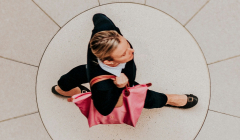
Supporting women through the messy middle of their careers
International Women’s Day may well be over, but progressive agency leaders remain focused on supporting women at every stage of their careers.

The Paralympics TikTok account’s use of humour has divided audiences. Lisa Nichols champions the power of humour for driving connection

Hands up, who loves a good laugh?
I’m going to hazard a guess that the answer to that is ummm…everyone.
Humour is a universal emotion, inherently inclusive and naturally sharable.
Humour works in advertising, in fact for our industry ‘shareable’ is an invaluable commodity.
The facts and figures and data are all clear.
It works. (Specsavers anyone?)
It’s no surprise then that 2024 saw the Cannes Festival of Creativity introduce a Use of Humour category. In their official 2024 wrap-up of insights and trends, they stated that if a brand uses humour 80% of people are more likely to buy from the brand, 72% are more likely to choose that brand over their competition and 63% will spend more. Yet despite these figures 95% of business leaders ‘fear’ using humour in their comms. Because it’s not easy to get right and so easy to get it wrong. Especially when you introduce a subject that might once have been seen as ‘taboo’, ‘sensitive’ or portraying a cause.
The subject that I’m referring to currently is disability and specifically how it is portrayed on the Paralympics TikTok account. Which is, it’s safe to say, dividing opinion. Despite being run by the IPC (International Paralympic Committee), with support from Paralympic athletes, the account has drawn both positive and negative attention, especially for its use of meme-style humour.
To be clear as an able-bodied person, I wouldn’t want to speak on anyone’s behalf, and I do think that there is a balance to strike. But as Jonas Oliveira, said in her TedTalk, “There shouldn’t be a difference in the way you treat athletes, be it Olympians, able-bodied or athletes with disabilities.”
We shouldn’t be the gatekeepers for who can or can’t laugh at what, but we should be more accountable when it comes to opening the door to more visibility for people with disability.
Lisa Nichols, Executive Creative Director, TBWA\MCR
The two things aren’t or shouldn’t be mutually exclusive, in fact, I’d say they’re an undeniably powerful combination - especially when you get it right.
Maltesers and their 2016 ‘Look on the light side’ campaign is a standout example of where a brand got it right.
In a quote taken from The Valuable 500’s white paper “Nothing About Us, Without Us”, CEO Katy Kalitowska says: “This campaign marked the brand’s pioneering use of humour, candour, and authentic, everyday portrayals of disabled individuals. We worked directly with disabled young women and asked them to tell their stories. We cast disabled talent and created ads that were funny, inclusive, and relatable.”
The campaign results speak for themselves. 1.5 million social media impressions within 24 hours. A 7% sales increase. A survey revealing that 44% of disabled consumers felt the campaign altered national perceptions of disability.
More personal experience of this comes from a project we’re working on at TBWA\MCR for Blesma – a charity for limbless veterans. They don’t want to be used as ‘inspiration porn’ they have real lives, real issues and shock, horror, a wicked sense of humour.
We shouldn’t be the gatekeepers for who can or can’t laugh at what, but we should be more accountable when it comes to opening the door to more visibility for people with disability.
So perhaps the combination of taboo, inclusion and humour is needed, and perhaps the more brands that step up, the better it will be for everyone involved.
And ‘involved’ is the key word here, because as much as you (as an abled-bodied person) might be offended on their behalf, that’s possibly the last thing anyone with a disability wants, they want you to ask what they think and feel, understand their experiences, rather than assuming you can speak for them and then maybe, in the nicest sense, get out of the way and let them be seen.
People living with disabilities are still nearly unseen in advertising. According to the WHO, 16% of the world’s population have some form of disability, yet they feature in less than 2% of ads.
Humour, whether that’s on a platform like TikTok or in other media could be just one way the industry can help increase visibility.
Remember, a smile costs nothing.
But if you need more of an incentive, then how about this.
Not raising a smile could mean you’re ignoring an $8 trillion a year market.
Yep.
That’s right, 16% of the global population, that’s around 1.3 billion, is made up of people with a disability.
But here's the thing.
We shouldn’t be doing it for the money.
We should be doing it simply because it’s just the right thing to do.
And it’s about bloody time.
When we nail this as creators/brands/human beings – we’ll all be laughing, but we’ll be laughing for all the right reasons.
Lisa Nichols is the Executive Creative Director at TBWA\MCR
Looks like you need to create a Creativebrief account to perform this action.
Create account Sign inLooks like you need to create a Creativebrief account to perform this action.
Create account Sign in